The main points in growing castor oil plants are planting and care
Castor oil plant belongs to the Euphorbia family, which is represented by one species. The mention of the plant has been found since the time of the ancient Egyptians, the inhabitants of Ancient Rome, seeing that the seeds look like a tick, so they called the plant - "tick". Castor oil plants were originally native to Ethiopia and also in the tropics. The plant is widespread in Ukraine, in the territory of Russia in the wild, castor oil plant grows in the southern regions.
Content:
- Plant features
- Castor bean varieties
- Reproduction of castor bean
- Planting castor bean
- Plant care
- Diseases and pests
- Seed collection
- The benefits and harms of castor bean
Plant features
Castor oil plant is an ornamental perennial or annual plant. Bushes castor bean can reach two or three meters in height (in hot climates it grows up to 10 meters). Stems are highly branched, palm-like, bright green, brownish blue or purple in color.
The leaves are large, saturated green with a reddish tint.
There are leaves that are bright red or dark lilac, ranging in size from 30 to 80 centimeters, divided into beautiful oblong lobes. They look like maple trees.
Castor bean blooms in summer, after flowering fruits appear that look like small round boxes with sharp thorns about three centimeters in diameter. Depending on the variety, they are red, pink, brown or green.
Other names:
- Palm of christ
- Castor beans
- Paradise tree
- Turkish hemp
Castor bean varieties
In the temperate zone due to the rather cold climate the seeds castor bean do not have time to ripen, therefore it is grown as ornamental plant in gardens and personal plots.
The most popular domestic varieties:
- Cossack - the most widespread variety in floriculture - has leaves of beautiful saturated purple color with a greenish tint, boxes with seeds of various shades of red. The branches are rich red-brown colors, the flowers are bright red.
- Serenade - leaves with a dark purple tint, the stems are pinkish-purple. Branches and leaves seem to be covered with wax. Boxes with seeds are lilac, purple, collected in oblong clusters. Until the onset of frost, this variety will decorate your site.
- Autumn Rhapsody is a very beautiful plant with large bright green, lemon-yellow seed pods growing in inflorescences up to 60 cm long.
- Khrustalnaya 66 is considered an early maturing variety. It is cultivated to obtain seeds, which are later used for technical purposes.
Reproduction of castor bean
The castor oil plant is propagated seeds... Even for inexperienced hobbyists, it will not be difficult to plant a plant.
Features of reproduction using seeds:
- The seeds are covered with a dense shell and germinate for a long time. Sow seedlings best in early March.
- Before landing the seeds it is recommended to soak in warm water for a day, this will help accelerate germination. Change the water periodically.
- Plant the plant to a depth of one to two centimeters in large peat cups filled with soil, which are recommended to be placed in clay pots.This will help to avoid damage to the roots when transplanting seedlings into a large container.
- Pour soil into cups or pots about two-thirds of the height so that you can add soil.
- After landing cover the seed containers with foil for 7 days and place in a place where it is possible to maintain an air temperature of about 15 degrees.
- After a week, the seed containers can be placed on the sunny side. Seedlings do not appear earlier than after 3 weeks. Since the shell is very dense, help the seed out (carefully remove the shell-shell with tweezers).
Before planting in open ground, seedlings can be taken out to the balcony for hardening. Water regularly seedlings and add soil as the seedlings grow.
Seeds can be sown directly into open ground. They do it in May. Prepare the soil first: add compost and humus to the soil. In the beds, make grooves about 10 centimeters at a distance of at least one meter from each other, put two or three seeds in each and cover with earth. Shoots should appear in three weeks. Be sure to carefully remove the shell, otherwise the seedlings may rot and die.
The best temperature for seed germination is 14-15 degrees.
To facilitate germination, you can lightly "walk" over the seeds with sandpaper. During and after planting, you do not need to water the soil; do this only after the first sprout appears. When planting seeds, keep in mind that the germination rate is approximately 50%.
Planting castor bean
To a permanent place seedlings planted when frosts finally stop (late May or early June). Castor oil plant, as a southern plant, does not tolerate a cold climate, and young shoots can die in frost. The plant does not like areas exposed to winds.
For planting, choose a well-lit, sunny location with fertile soil.
If the soil is not fertile enough, add more humus and compost to it before planting. The soil must also be drained, air and water permeable. Another way to prepare the soil: a week before planting, dig a hole about half a meter deep, fill it with manure up to half, add earth on top and cover with plastic.
Make the holes shallow, only to close the root system and trunk to the first leaf when planting. After disembarking, lightly press down on the ground.
Always remember - the plant is very poisonous. Avoid growing castor oil plants in areas where you spend a lot of time. Plant the plants directly in a peat cup or with a clod of soil (if you sowed seeds in a plastic container), trying to keep the root system intact. Until the seedling hardens, tie it to a support.
Plant care
Castor oil plant is very unassuming in grooming and does not require much effort from you. But still, for better growth, it must be fed with complex mineral fertilizers... Until the inflorescences begin to form, nitrogenous fertilizers can be applied to the soil. Water liberally to better dissolve the fertilizer in the soil.
With constant feeding, the castor oil plant grows very quickly.
Plant care is very simple:
- Loosen the soil regularly.
- Weeds greatly impede the development of young seedlings. When the soil is cleared of weeds, castor bean grows well even with a lack of watering. But in arid lands, the plant loses its beauty.
- When growing castor bean, take special care: do all work only with gloves, avoiding contact with the skin, and wash your hands after finishing.
- Although castor oil plant is an unpretentious plant, it needs a good watering... Water the plants every five days throughout the summer season, 10 liters per plant.
Diseases and pests
Due to its poisonous qualities, castor oil plants are rarely attacked. pests.
Pests that can infect castor oil plants:
- Wireworm
- Winter caterpillar
- False wire
- Cotton scoop
In order to control pests, various insecticides with a wide spectrum of action can be used.
Castor bean diseases:
- Gray rot
- Sclerocinosis
- Macrosporiasis
- Late blight
- Fusarium
To avoid diseases, buy the seeds in specialized reliable stores and grow the plant in the same area no earlier than once every eight years. It is possible to pickle the seeds before sowing - for this, 2 grams of 80% of the preparation "Granozam" are taken for 1 kg of seeds.
Seed collection
Seeds ripen in August. To collect them, choose the most powerful shoots, removing small ones nearby. Fruit similar to pyramids, consisting of red or green thorny tricuspid balls. Each ball contains two or three seeds of variegated color, oval or round. The color and shape make the seeds look like ticks. They can be taken out immediately or dried first, but when the balls dry, the thorns become very sharp, and you can pierce your fingers.
After removing the seeds, dry them for two weeks by spreading them out on paper. Then put in paper bags and store until spring.
If the summer is rainy, the seeds will not mature in time; if there are small children or pets in the house, take extra care. It is important to remember that the most ricin is found in the seeds.
Never try to make castor oil from seeds at home! To remove ricin, industrial processing is used using a special technology. A large number of people died using the product obtained at home... Castor oil plant is a perennial plant, but since it does not tolerate cold weather, it grows as an annual in the temperate zone. It is removed in the fall. The branches can be finely chopped, then buried in the ground (on the surface, the hollow stems will not rot).
If you are going to grow castor bean, appreciate the beauty and poisonous properties. If there are small children in the house, it may be better to refrain from planting an ornamental exotic plant.
The benefits and harms of castor bean
Semena Plants contain a large amount of fatty oil (up to 60%), the main component is castor oil (rhinocelic acid), as well as lipase, glycerin. acids (stearic, linoleic, oleic), globulin, albumin, cellulose, in a small amount alkaloids and nitrogen-free substances, various micro and macro elements (iron, calcium, potassium, magnesium, etc.).
Castor oil, widely known for its medicinal properties, is prepared from the seeds of the plant.
Castor oil contains a potent poison - ricin, which is as potent as cyanide and is 12,000 times more potent than the venom of a rattlesnake. The fatal human dose of ricin is 70 micrograms. No antidote has been developed at this time. In the production of castor oil from the seeds, cake remains, in which the concentration of ricin is very high.
Seeds Castor bean is strictly forbidden to eat or just try.
In case of accidental use, immediately perform a gastric lavage! Castor oil (absolutely non-hazardous product) is used in traditional medicine, traditional healers also use it. Doctors recommend using castor oil for the treatment of various diseases of the gastrointestinal tract, in gynecology, as a wound healing agent for ulcers and burns. The infusion of the leaves is used as a rubbing for colds.
More information can be found in the video.




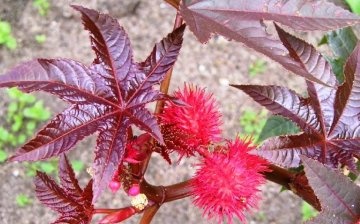
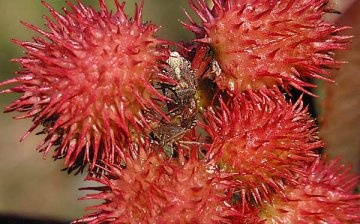
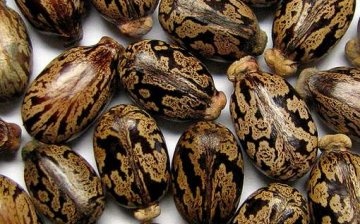
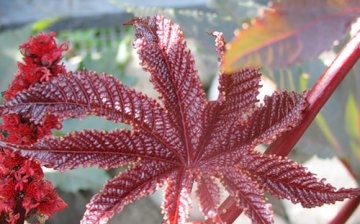
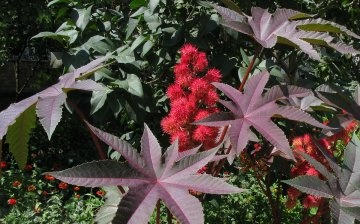
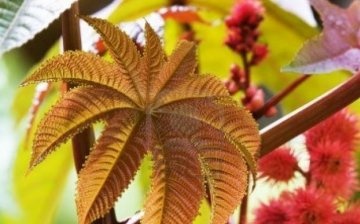

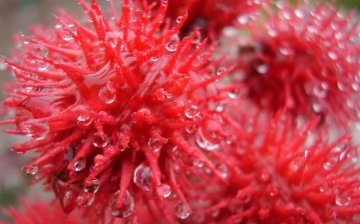









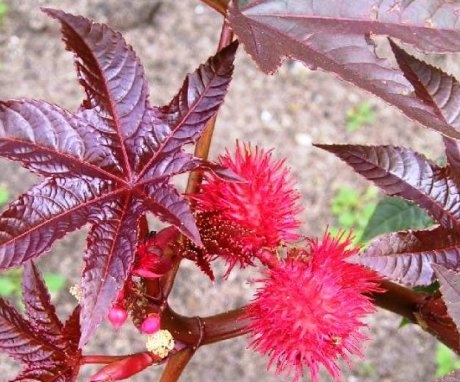

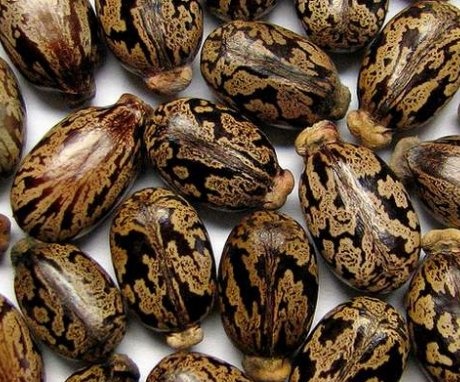

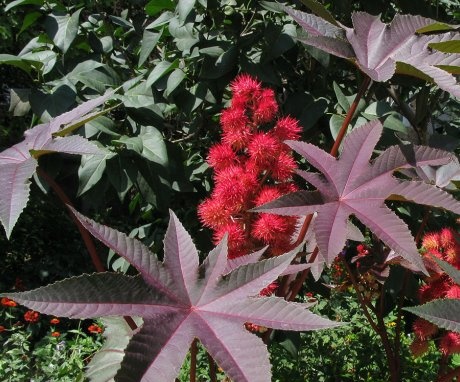
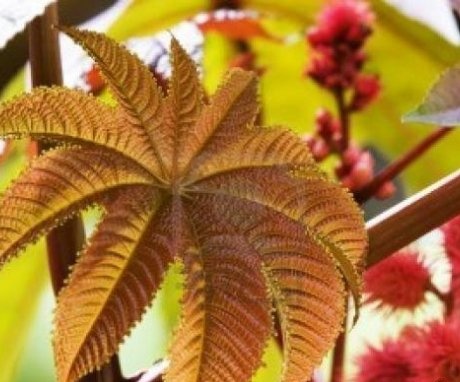
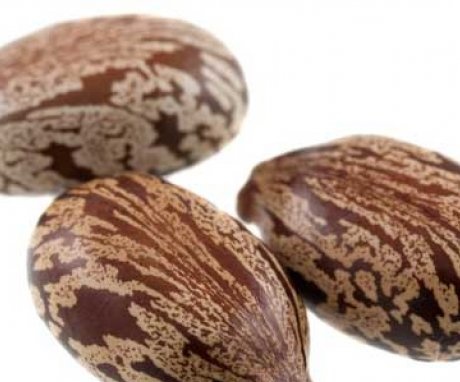
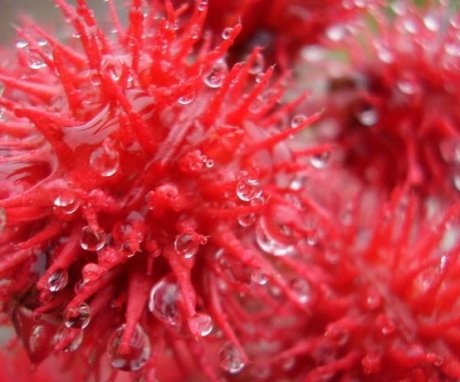
I plant castor bean seeds in pots even in winter. Due to the dense shell, they sprout for a very long time - about a month. And when it gets warmer, I gently transplant them into the ground. The main thing is not to rush - the castor oil plant does not like frost.